Stan C. Smith's Blog
November 26, 2025
Life's Great Mysteries - Could you be friends with a clone of yourself?
My curious mind never rests. This is a fascinating question, right? If somehow there could instantly be an exact copy of you, could that person become your good friend? I know... a clone is really the same thing as an identical twin, and twins develop many personality (and even physical) differences during their lifetimes. But I'm talking about the common science fiction concept of creating a copy that is identical to you as you are right now. Same memories, same experiences, same everything.
First, there are reasonable arguments for and against creating a copy of yourself. First, assuming your copy is willing, you could accomplish a lot more with two than with one. Some people might think: I wouldn’t have to go to work! Well, that’s probably wrong. Remember, your clone is just like you, so your clone also doesn’t want to go to work. You might have to establish an agreement where you alternate days with your clone… which does mean you would only have to go to work half the time. But then you’d have to spend a lot of time each day briefing each other on what you accomplished that day at work so you wouldn’t get totally confused the next morning when you get there. And you would have to share one salary!
It might benefit you to observe yourself from an outside perspective (not just in a mirror). You could watch your clone’s mannerisms, gestures, facial expressions, allowing you to recognize and change your annoying habits. I’m sure there is a lot we could learn about ourselves… from ourselves.
There are also some pretty serious negative consequences. If a copy of you suddenly appears, which one of you actually owns your house and other property? Which of you really loves your spouse and all your friends? Would your spouse have to choose one of you? With only one job, you now have two people to feed and clothe. The new person would need their own social security number, health insurance, driver’s license, and bank accounts. Uh-oh, I’m going down a deep rabbit hole with this.
So, back to the original Great Mystery… could you and your clone be friends? A tough question. It forces us to ask: Knowing exactly who I am, would I be willing to hang around with myself for fun? Different people might answer this differently. Trish and I are best friends partly because we are different. When I am feeling quiet and contemplative, she talks and fills the gaps. Sometimes, it’s the other way around. I tend to be impulsive to a fault, while she plans and considers consequences. If two people are exactly the same, could they really be friends? After all, we spend every waking hour with ourselves already. Could we really tolerate another copy of ourselves? I suppose we would laugh at the same jokes and enjoy the same TV shows. But I think the similarities would become tiresome.
However, here’s how I think it could work. I could send my clone off on his own, to have his own experiences, say, for a year. Then, when he comes back, his experiences would have changed him enough, and my experiences would change me enough, that we would no longer be identical, and we would then have things to talk about.
Of course, the problem is, he would be me. He would not want to leave his wife, his home, his family any more than I would. *Sigh* No... this just wouldn't work at all. I do NOT want a copy of myself!

First, there are reasonable arguments for and against creating a copy of yourself. First, assuming your copy is willing, you could accomplish a lot more with two than with one. Some people might think: I wouldn’t have to go to work! Well, that’s probably wrong. Remember, your clone is just like you, so your clone also doesn’t want to go to work. You might have to establish an agreement where you alternate days with your clone… which does mean you would only have to go to work half the time. But then you’d have to spend a lot of time each day briefing each other on what you accomplished that day at work so you wouldn’t get totally confused the next morning when you get there. And you would have to share one salary!
It might benefit you to observe yourself from an outside perspective (not just in a mirror). You could watch your clone’s mannerisms, gestures, facial expressions, allowing you to recognize and change your annoying habits. I’m sure there is a lot we could learn about ourselves… from ourselves.
There are also some pretty serious negative consequences. If a copy of you suddenly appears, which one of you actually owns your house and other property? Which of you really loves your spouse and all your friends? Would your spouse have to choose one of you? With only one job, you now have two people to feed and clothe. The new person would need their own social security number, health insurance, driver’s license, and bank accounts. Uh-oh, I’m going down a deep rabbit hole with this.
So, back to the original Great Mystery… could you and your clone be friends? A tough question. It forces us to ask: Knowing exactly who I am, would I be willing to hang around with myself for fun? Different people might answer this differently. Trish and I are best friends partly because we are different. When I am feeling quiet and contemplative, she talks and fills the gaps. Sometimes, it’s the other way around. I tend to be impulsive to a fault, while she plans and considers consequences. If two people are exactly the same, could they really be friends? After all, we spend every waking hour with ourselves already. Could we really tolerate another copy of ourselves? I suppose we would laugh at the same jokes and enjoy the same TV shows. But I think the similarities would become tiresome.
However, here’s how I think it could work. I could send my clone off on his own, to have his own experiences, say, for a year. Then, when he comes back, his experiences would have changed him enough, and my experiences would change me enough, that we would no longer be identical, and we would then have things to talk about.
Of course, the problem is, he would be me. He would not want to leave his wife, his home, his family any more than I would. *Sigh* No... this just wouldn't work at all. I do NOT want a copy of myself!

Published on November 26, 2025 06:35
In our neck of the woods... A turkey murder mystery.
I was hiking in the forest near our house recently, and I came upon this carcass of an eastern wild turkey (the eastern wild turkey is one of the four subspecies of wild turkeys living in North America). I immediately determined this turkey was a tom... a mature male. Notice the sharp spur on the leg bone. The spur isn't real long, but it's longer than the spurs of a jake (a juvenile male turkey). The second photo is a close-up of the leg bone and spur, an important bit of forensic evidence.
It's time to put on our Sherlock Holmes hats, folks, because murder is afoot. Or should I say fowl play?
Something—or someone—murdered this turkey, and I aim to sleuth it out (can sleuth be a verb?). Your ideas are welcome, so feel free to contribute to solving the mystery of this dastardly deed.
First, let's rule out some suspects. Although October happens to be one of the hunting seasons for turkeys in Missouri, I offer my opinion that a human was not involved. Why? Well, based on the advanced state of decomposition of this body, it must have been killed long before October. It's mostly feathers and clean, white bones. Also, when humans kill turkeys, they take them home and eat them. They do not leave them on the ground. Also, this carcass is on our property, and we have never seen or heard trespassers here. The carcass is far from the nearest road, so not a roadkill.
I'll also offer my opinion that this bird did not die of old age. The spur is simply not long enough to belong to an old tom.
Could it have been an accident? Like flying into a tree trunk? Not likely. Turkeys are excellent flyers and rarely have such accidents. And they're tough birds.
Disease? Possible. Turkeys sometimes die of diseases such as avian Influenza or avian pox. However, while wild turkeys occasionally get sick, disease does not play a major role in overall wild turkey mortality. Although disease is a possible suspect, I'm ruling it out simply based on low probability.
The process of elimination leads me to a PREDATOR as the culprit. But what predator? Turkeys roost in trees at night. Therefore, the adults rarely fall prey to coyotes, bobcats, and other predators that normally hunt at night (whereas turkey eggs and flightless poults—babies—often do). However, coyotes and bobcats do sometimes hunt during the day, and they are excellent ambush hunters (they sneak up on prey and leap onto them with a sudden burst of speed), but this was in an area of forest with little cover. Besides, I did not see any broken bones—a coyote or bobcat would likely crunch some of the bones while feeding on the bird. The breast bone, in particular, would have been crunched, but you can see it is intact.
Birds of prey, on the other hand, usually just pick the meat from the bones with their razor-sharp beak, leaving the bones intact.
I could be wrong, of course, but I conclude that this bird was likely killed by a bird of prey, probably either a great horned owl, a barred owl, or a red-shouldered hawk (the only three large birds of prey that hunt in the forest around here). We have a lot of bald eagles here, but I've never seen one hunt birds in a dense forest. Considering owls hunt at night, a roosting turkey, though quite large, would be a logical prey option. Numerous barred owls live in the area, so my primary suspect is a BARRED OWL (third photo).
Do you have any suggestions that might change my conclusion? After all, what kind of sleuth would I be if I didn't listen to the opinions of others?
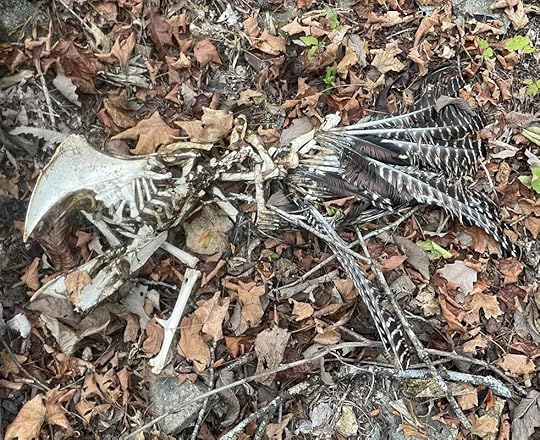
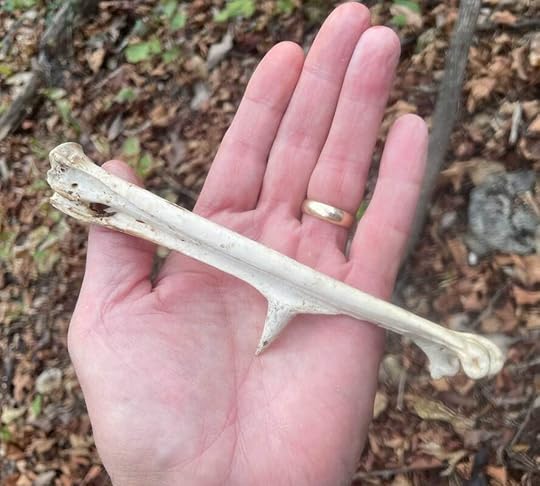
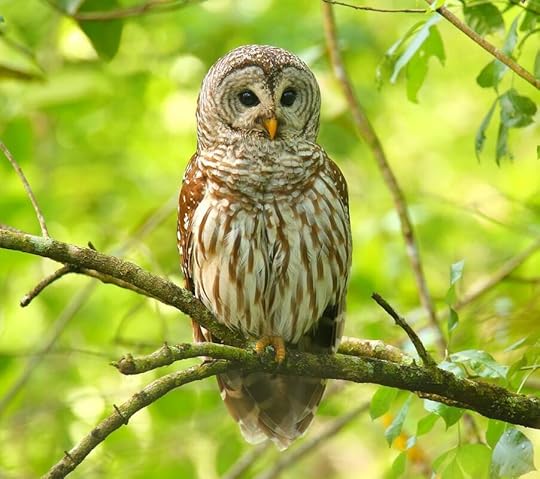
Photo Credits:
- Eastern turkey carcass - Stan C. Smith
- Barred owl - DepositPhoto
It's time to put on our Sherlock Holmes hats, folks, because murder is afoot. Or should I say fowl play?
Something—or someone—murdered this turkey, and I aim to sleuth it out (can sleuth be a verb?). Your ideas are welcome, so feel free to contribute to solving the mystery of this dastardly deed.
First, let's rule out some suspects. Although October happens to be one of the hunting seasons for turkeys in Missouri, I offer my opinion that a human was not involved. Why? Well, based on the advanced state of decomposition of this body, it must have been killed long before October. It's mostly feathers and clean, white bones. Also, when humans kill turkeys, they take them home and eat them. They do not leave them on the ground. Also, this carcass is on our property, and we have never seen or heard trespassers here. The carcass is far from the nearest road, so not a roadkill.
I'll also offer my opinion that this bird did not die of old age. The spur is simply not long enough to belong to an old tom.
Could it have been an accident? Like flying into a tree trunk? Not likely. Turkeys are excellent flyers and rarely have such accidents. And they're tough birds.
Disease? Possible. Turkeys sometimes die of diseases such as avian Influenza or avian pox. However, while wild turkeys occasionally get sick, disease does not play a major role in overall wild turkey mortality. Although disease is a possible suspect, I'm ruling it out simply based on low probability.
The process of elimination leads me to a PREDATOR as the culprit. But what predator? Turkeys roost in trees at night. Therefore, the adults rarely fall prey to coyotes, bobcats, and other predators that normally hunt at night (whereas turkey eggs and flightless poults—babies—often do). However, coyotes and bobcats do sometimes hunt during the day, and they are excellent ambush hunters (they sneak up on prey and leap onto them with a sudden burst of speed), but this was in an area of forest with little cover. Besides, I did not see any broken bones—a coyote or bobcat would likely crunch some of the bones while feeding on the bird. The breast bone, in particular, would have been crunched, but you can see it is intact.
Birds of prey, on the other hand, usually just pick the meat from the bones with their razor-sharp beak, leaving the bones intact.
I could be wrong, of course, but I conclude that this bird was likely killed by a bird of prey, probably either a great horned owl, a barred owl, or a red-shouldered hawk (the only three large birds of prey that hunt in the forest around here). We have a lot of bald eagles here, but I've never seen one hunt birds in a dense forest. Considering owls hunt at night, a roosting turkey, though quite large, would be a logical prey option. Numerous barred owls live in the area, so my primary suspect is a BARRED OWL (third photo).
Do you have any suggestions that might change my conclusion? After all, what kind of sleuth would I be if I didn't listen to the opinions of others?



Photo Credits:
- Eastern turkey carcass - Stan C. Smith
- Barred owl - DepositPhoto
Published on November 26, 2025 06:28
October 10, 2025
In our neck of the woods... the beautiful but little known passion flower.
We're lucky to have quite a few of these amazing plants growing wild on our property. I had never heard of them until we moved here six years ago.
These plants are vines that climb on other plants, but rarely more than about six feet high. The flowers are stunning and exotic-looking, yet they are native to Missouri and much of the eastern United States. The flowers are awesome, and the resulting fruits are delicious. The fruits are sometimes called Maypops because when the fruits ripen (in May in southern locations), they pop loudly when you squeeze them. Anyway, inside the fruits are a bunch of seeds coated with delicious sweet gooey stuff (kind of like pomegranates). When Trish and I find these when we are on a walk, we pop them open, slop the seeds into our mouths, and suck all the gooey goodness off before spitting out the seeds.
Passion flowers got their name when early Spanish missionaries came to the Americas and came up with the idea that certain aspects of the flower represented Christ's crucifixion (referred to as the "passion").
These flowers are great for attracting butterflies and hummingbirds. They also have a long history of medicinal uses, to relieve anxiety, insomnia, pain, epilepsy and high blood pressure. Anyway, I just like the beauty of the flowers and the yumminess of the gooey fruits.


Photo Credits:
- Passion flower - Stan C. Smith
- Passion flower with fruit - DepositPhotos
These plants are vines that climb on other plants, but rarely more than about six feet high. The flowers are stunning and exotic-looking, yet they are native to Missouri and much of the eastern United States. The flowers are awesome, and the resulting fruits are delicious. The fruits are sometimes called Maypops because when the fruits ripen (in May in southern locations), they pop loudly when you squeeze them. Anyway, inside the fruits are a bunch of seeds coated with delicious sweet gooey stuff (kind of like pomegranates). When Trish and I find these when we are on a walk, we pop them open, slop the seeds into our mouths, and suck all the gooey goodness off before spitting out the seeds.
Passion flowers got their name when early Spanish missionaries came to the Americas and came up with the idea that certain aspects of the flower represented Christ's crucifixion (referred to as the "passion").
These flowers are great for attracting butterflies and hummingbirds. They also have a long history of medicinal uses, to relieve anxiety, insomnia, pain, epilepsy and high blood pressure. Anyway, I just like the beauty of the flowers and the yumminess of the gooey fruits.


Photo Credits:
- Passion flower - Stan C. Smith
- Passion flower with fruit - DepositPhotos
Published on October 10, 2025 07:32
October 1, 2025
Life's great mysteries - Is there a limit to how intelligent a single person can be?
There's no end to the weird questions I ponder. But seriously… how intelligent can an individual person get? Are there biological or physical limits? This question doesn’t have a simple answer. But, hey… I don’t call these Life’s Great Mysteries for nothin’. Let’s dig in.
Some researchers believe human intelligence has no limits. To me, this seems rather far-fetched, but let’s consider the arguments. These researchers argue that their computer models of brain function show that human thought can endlessly generate new deductions and inferences… as long as cognitive processes persist. In other words, if a human could live forever, without ever experiencing cognitive degradation, there may be no limit to increasing intelligence.
Well then, it seems to me that the human lifespan, and more importantly, the cognitive decline as we age, automatically limits intelligence.
Anyway, despite what I said above, most research seems to indicate there are biological and physical limits to human intelligence. For example, the size of the human brain already pushes the limits of what can fit through the birth canal during childbirth. I suppose human females could evolve larger birth canals to accommodate larger brains (obviously, they already have, right?). But some scientists think, as bipedal creatures, we’ve already hit that limit (much larger birth canals would impede walking and running).
Okay, so maybe our brains can’t get much larger. But what if our brains developed more densely-packed neurons, or our neurons developed a way to transmit signals even faster? Unfortunately, due to the nature of neurons, there seems to be physical limits to both of these possibilities, and human brains (as well as brains of other animals) may have already reached these limits long ago. As adults, our brains already use 20% of the calories we consume, even though the brain is only 2% of our body weight. And with children, the brain can consume up to 65% of the body’s energy! Could our bodies even support a brain that requires much more energy?
Where does this leave us? Have we reached the limit of human intelligence? Maybe. When it comes to the impact of artificial intelligence (AI), I can see two arguments: Some people might suggest augmenting our own intelligence with AI will take us to the next level. Other people might suggest our reliance on AI will result in no need for our brains to continue evolving, and therefore we have already stalled out.
My opinion? I’ll use the words of Dr. Ian Malcolm (from Jurassic Park): Nature finds a way.

Photo Credits:
- Cloud brain - Midjourney 7
Some researchers believe human intelligence has no limits. To me, this seems rather far-fetched, but let’s consider the arguments. These researchers argue that their computer models of brain function show that human thought can endlessly generate new deductions and inferences… as long as cognitive processes persist. In other words, if a human could live forever, without ever experiencing cognitive degradation, there may be no limit to increasing intelligence.
Well then, it seems to me that the human lifespan, and more importantly, the cognitive decline as we age, automatically limits intelligence.
Anyway, despite what I said above, most research seems to indicate there are biological and physical limits to human intelligence. For example, the size of the human brain already pushes the limits of what can fit through the birth canal during childbirth. I suppose human females could evolve larger birth canals to accommodate larger brains (obviously, they already have, right?). But some scientists think, as bipedal creatures, we’ve already hit that limit (much larger birth canals would impede walking and running).
Okay, so maybe our brains can’t get much larger. But what if our brains developed more densely-packed neurons, or our neurons developed a way to transmit signals even faster? Unfortunately, due to the nature of neurons, there seems to be physical limits to both of these possibilities, and human brains (as well as brains of other animals) may have already reached these limits long ago. As adults, our brains already use 20% of the calories we consume, even though the brain is only 2% of our body weight. And with children, the brain can consume up to 65% of the body’s energy! Could our bodies even support a brain that requires much more energy?
Where does this leave us? Have we reached the limit of human intelligence? Maybe. When it comes to the impact of artificial intelligence (AI), I can see two arguments: Some people might suggest augmenting our own intelligence with AI will take us to the next level. Other people might suggest our reliance on AI will result in no need for our brains to continue evolving, and therefore we have already stalled out.
My opinion? I’ll use the words of Dr. Ian Malcolm (from Jurassic Park): Nature finds a way.

Photo Credits:
- Cloud brain - Midjourney 7
Published on October 01, 2025 11:52
September 27, 2025
Loons and Monarchs.
As I've mentioned, Trish and I recently returned from and fun adventure up north (Superior National Forest in Minnesota and the UP of Michigan).
One of our favorite animals in the north woods is the common loon. These fish-eating predators are often seen floating in the lakes and diving under to catch fish. They can stay underwater for a surprisingly long time. Underwater, they dart around like torpedoes, using their huge webbed feet to propel them. They are fast enough to catch fish, but they also eat crayfish.
The call of the loon is hauntingly beautiful... a long, drawn-out, lonely sounding howl. Loons often do this at night, then you'll hear another loon, perhaps floating on another lake in the distance, return the call. It's almost like they're lonely, and they just want to make sure other loons know they are there. I took this loon photo from the porch of our rustic cabin.
After a week of paddling (and hiking) in Minnesota, we drove over to the Upper Peninsula of Michigan to visit some good friends. We were lucky to be there at the time of the monarch butterfly migration. Monarchs heading south from Canada must fly nonstop across vast Lake Michigan, which could be as much as 280 miles over open water if the butterflies head straight south. Anyway, many monarchs fly to the tip of a certain peninsula, and they pause there to rest and to consume as much nectar as they can before taking off across the massive lake. We drove to the point to see them and were not disappointed. Thousands of monarchs had gathered there, getting themselves psyched up for hopping over the pond.


One of our favorite animals in the north woods is the common loon. These fish-eating predators are often seen floating in the lakes and diving under to catch fish. They can stay underwater for a surprisingly long time. Underwater, they dart around like torpedoes, using their huge webbed feet to propel them. They are fast enough to catch fish, but they also eat crayfish.
The call of the loon is hauntingly beautiful... a long, drawn-out, lonely sounding howl. Loons often do this at night, then you'll hear another loon, perhaps floating on another lake in the distance, return the call. It's almost like they're lonely, and they just want to make sure other loons know they are there. I took this loon photo from the porch of our rustic cabin.
After a week of paddling (and hiking) in Minnesota, we drove over to the Upper Peninsula of Michigan to visit some good friends. We were lucky to be there at the time of the monarch butterfly migration. Monarchs heading south from Canada must fly nonstop across vast Lake Michigan, which could be as much as 280 miles over open water if the butterflies head straight south. Anyway, many monarchs fly to the tip of a certain peninsula, and they pause there to rest and to consume as much nectar as they can before taking off across the massive lake. We drove to the point to see them and were not disappointed. Thousands of monarchs had gathered there, getting themselves psyched up for hopping over the pond.



Published on September 27, 2025 07:15
September 18, 2025
North Woods Adventure
Trish and recently returned from a week in the north woods of northern Minnesota (for canoeing). I have many stories to share, but today I'll start with a hike we took in Superior National Forest in Minnesota between our paddling adventures.
We pulled over at the trailhead of the Magnetic Rock Trail. The trail is only three miles, and was supposed to be an easy hike. Well, it wasn't quite as easy as we imagined, and three miles can seem like a long distance when you are stepping over countless boulders and bushwhacking around fallen trees. So it ended up taking more than three hours.
The destination was an odd sixty-foot-high rock that glaciers had deposited in this vertical position instead of flat on the ground.
And the rock is magnetic. We took compasses with us, and when we held them up near the rock's surface, the needles went wacky.
How does such a magnetic rock form? Some rocks contain minerals that contain iron and act like tiny magnets. A LONG time ago, these minerals began to form as the lava (or magma) cooled. While the molten rocks had not yet solidified, the magnetic minerals floating in it became aligned to the Earth's magnetic field. Then, as the rocks solidified, these aligned minerals became locked in place. This can also happen with sedimentary rocks, but instead of floating in molten rock, the tiny minerals are deposited at the bottom of a body of water, and while they are still loose, they become aligned to the earth's magnetic field. Eventually, these sedimentary layers solidify into magnetic rock. Rock on!
As we hiked back to our vehicle, we noticed two ruffed grouse (grouses?) feeding on plants beside the trail. I only had my phone for a camera, so I crept closer. And then closer. And even closer. For whatever reason, these birds seemed totally unafraid of us. Finally, I held my phone about two feet away from one to take this photo.
Ruffed grouse don't live in Missouri, so this close encounter was rather exciting to me (it doesn't take much to excite me). Ruffed grouse are perhaps best known for the "drumming" behavior of males. Male grouse are aggressively territorial, and to proclaim their ownership of a section of forest, they stand on a log or rock (which is usually about twelve inches off the ground) and beat their wings really fast. So fast, in fact, that the motion creates a vacuum with each beat (as lightning does when it creates thunder). This makes a series of surprisingly loud drumming sounds.


We pulled over at the trailhead of the Magnetic Rock Trail. The trail is only three miles, and was supposed to be an easy hike. Well, it wasn't quite as easy as we imagined, and three miles can seem like a long distance when you are stepping over countless boulders and bushwhacking around fallen trees. So it ended up taking more than three hours.
The destination was an odd sixty-foot-high rock that glaciers had deposited in this vertical position instead of flat on the ground.
And the rock is magnetic. We took compasses with us, and when we held them up near the rock's surface, the needles went wacky.
How does such a magnetic rock form? Some rocks contain minerals that contain iron and act like tiny magnets. A LONG time ago, these minerals began to form as the lava (or magma) cooled. While the molten rocks had not yet solidified, the magnetic minerals floating in it became aligned to the Earth's magnetic field. Then, as the rocks solidified, these aligned minerals became locked in place. This can also happen with sedimentary rocks, but instead of floating in molten rock, the tiny minerals are deposited at the bottom of a body of water, and while they are still loose, they become aligned to the earth's magnetic field. Eventually, these sedimentary layers solidify into magnetic rock. Rock on!
As we hiked back to our vehicle, we noticed two ruffed grouse (grouses?) feeding on plants beside the trail. I only had my phone for a camera, so I crept closer. And then closer. And even closer. For whatever reason, these birds seemed totally unafraid of us. Finally, I held my phone about two feet away from one to take this photo.
Ruffed grouse don't live in Missouri, so this close encounter was rather exciting to me (it doesn't take much to excite me). Ruffed grouse are perhaps best known for the "drumming" behavior of males. Male grouse are aggressively territorial, and to proclaim their ownership of a section of forest, they stand on a log or rock (which is usually about twelve inches off the ground) and beat their wings really fast. So fast, in fact, that the motion creates a vacuum with each beat (as lightning does when it creates thunder). This makes a series of surprisingly loud drumming sounds.


Published on September 18, 2025 09:06
September 13, 2025
In our neck of the woods... Cool Moths
A couple of really cool moths showed up at our house recently. Trish spotted this first creature feeding on the nectar of our marigolds. From a distance, the way it hovers and darts left and right makes it look very much like a hummingbird. In fact, one of its names is hummingbird moth. Officially, its common name is the snowberry clearwing sphinx moth.
The caterpillars of snowberry clearwings are herbivores, feeding on leaves. The adults, though, feed exclusively on flower nectar, which makes them important pollinators. As they feed on flowers, pollen attaches to their body, and then they carry that pollen to other flowers.
This second one—an impressive luna moth—landed on our screen door.
Luna moths have a completely different life cycle compared to clearwing sphinx moths. As adults, sphinx moths feed on nectar, living for a few weeks to a few months. Adult luna moths, by contrast, do not eat at all.
Wait—what? They don't eat? It's true. Adult luna moths don't even have a mouth or digestive system. They rely on stored energy from when they were leaf-eating caterpillars. After they emerge from the cocoon as adults, they have only one goal in life... to find a mate and reproduce. They live only a few days to a week. At about midnight, the females release a pheromone that the males can detect from a great distance, and that's how they manage to hook up before they die.


The caterpillars of snowberry clearwings are herbivores, feeding on leaves. The adults, though, feed exclusively on flower nectar, which makes them important pollinators. As they feed on flowers, pollen attaches to their body, and then they carry that pollen to other flowers.
This second one—an impressive luna moth—landed on our screen door.
Luna moths have a completely different life cycle compared to clearwing sphinx moths. As adults, sphinx moths feed on nectar, living for a few weeks to a few months. Adult luna moths, by contrast, do not eat at all.
Wait—what? They don't eat? It's true. Adult luna moths don't even have a mouth or digestive system. They rely on stored energy from when they were leaf-eating caterpillars. After they emerge from the cocoon as adults, they have only one goal in life... to find a mate and reproduce. They live only a few days to a week. At about midnight, the females release a pheromone that the males can detect from a great distance, and that's how they manage to hook up before they die.


Published on September 13, 2025 06:02
September 9, 2025
Life's great mysteries - Would it be better to have a PAUSE button or a REWIND button for your life?
It occurs to me that some of the mysteries I contemplate get a little weird. But hey... I'm a sci-fi author, so weird is the way I roll.
When you were a kid, didn’t you wish you could have a PAUSE or a REWIND button? A PAUSE button would stop everything around you (except it wouldn’t stop you). A REWIND button would let you go back in time and do something over that you messed up. Which one you choose might say a lot about who you are.
Let’s consider these one at a time. A PAUSE button would allow you to pause when things get frantic, or just before doing something important, so you could contemplate it carefully or perhaps “phone a friend” for advice. Or, if you suddenly found yourself in a dangerous situation, you could pause and remove yourself from the danger, such as when you suddenly realize a car is about to run into you. Hmm… but I guess it wouldn’t help much if you slipped and were already falling. However, one could argue that access to a PAUSE button would lead to people becoming careless, which would result in getting themselves into more bad situations, perhaps even deadly ones in which a PAUSE button would not save them.
A REWIND button might allow you to correct mistakes, in hopes of achieving a different outcome. Or perhaps some people would use it to relive happy or thrilling moments. If you could use your REWIND button repeatedly, it might allow you to try things over and over until you figure it out (this reminds me of two movies: Groundhog Day with Bill Murray and Edge of Tomorrow with Tom Cruise). However, one could again argue that a REWIND button would cause a person to become apathetic, eventually not caring much about his or her actions. After all, if you can have a redo to fix every mistake you make, you might stop being careful. Also, there is a risk that, in the process of reliving something, you might change something else that causes a cascading effect and makes your future even worse.
Okay, I’ve talked myself out of both of these. I’ve decided I don’t want either one! Why? Because life’s risks and potential dangers are what keeps us on our toes, and they make life exciting.
But I still wonder what other people might choose. I dug into this question enough to realize that no psychologists have ever done a serious, large-scale study or survey to see what most people would choose. Well, now I want to know why no one has done a large survey on such an important question! Possible answers: First, this question is abstract, not easy to answer. So, researchers probably assume many people surveyed would simply not answer it, leading to what is called non-response bias, making the results unreliable. Second, large-scale surveys usually are designed to provide insights tied to product or policy improvements. A question like this is interesting, but it doesn’t really offer practical outcomes for businesses or institutions, making it a lower priority. Bummer.
My conclusion (pure speculation, or course)? If you’re a PAUSE person, you’re more focused on the present, on caution, and on savoring the moment. If you’re a REWIND person, you’re more focused on nostalgia, regrets, and a desire to fix past mistakes.
There you go... something to think about as you start your day today!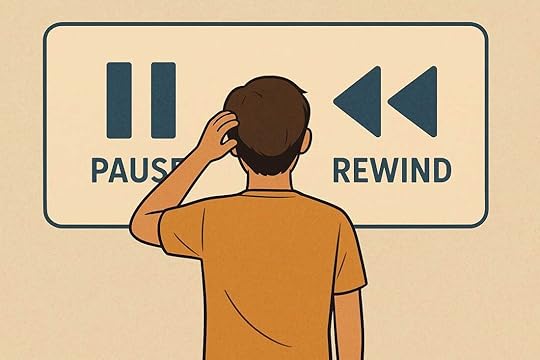
When you were a kid, didn’t you wish you could have a PAUSE or a REWIND button? A PAUSE button would stop everything around you (except it wouldn’t stop you). A REWIND button would let you go back in time and do something over that you messed up. Which one you choose might say a lot about who you are.
Let’s consider these one at a time. A PAUSE button would allow you to pause when things get frantic, or just before doing something important, so you could contemplate it carefully or perhaps “phone a friend” for advice. Or, if you suddenly found yourself in a dangerous situation, you could pause and remove yourself from the danger, such as when you suddenly realize a car is about to run into you. Hmm… but I guess it wouldn’t help much if you slipped and were already falling. However, one could argue that access to a PAUSE button would lead to people becoming careless, which would result in getting themselves into more bad situations, perhaps even deadly ones in which a PAUSE button would not save them.
A REWIND button might allow you to correct mistakes, in hopes of achieving a different outcome. Or perhaps some people would use it to relive happy or thrilling moments. If you could use your REWIND button repeatedly, it might allow you to try things over and over until you figure it out (this reminds me of two movies: Groundhog Day with Bill Murray and Edge of Tomorrow with Tom Cruise). However, one could again argue that a REWIND button would cause a person to become apathetic, eventually not caring much about his or her actions. After all, if you can have a redo to fix every mistake you make, you might stop being careful. Also, there is a risk that, in the process of reliving something, you might change something else that causes a cascading effect and makes your future even worse.
Okay, I’ve talked myself out of both of these. I’ve decided I don’t want either one! Why? Because life’s risks and potential dangers are what keeps us on our toes, and they make life exciting.
But I still wonder what other people might choose. I dug into this question enough to realize that no psychologists have ever done a serious, large-scale study or survey to see what most people would choose. Well, now I want to know why no one has done a large survey on such an important question! Possible answers: First, this question is abstract, not easy to answer. So, researchers probably assume many people surveyed would simply not answer it, leading to what is called non-response bias, making the results unreliable. Second, large-scale surveys usually are designed to provide insights tied to product or policy improvements. A question like this is interesting, but it doesn’t really offer practical outcomes for businesses or institutions, making it a lower priority. Bummer.
My conclusion (pure speculation, or course)? If you’re a PAUSE person, you’re more focused on the present, on caution, and on savoring the moment. If you’re a REWIND person, you’re more focused on nostalgia, regrets, and a desire to fix past mistakes.
There you go... something to think about as you start your day today!

Published on September 09, 2025 06:14
September 5, 2025
Bandicoots... Yaaay!
Lately, I've been working hard to prepare two of my series for audiobook narration—Bridgers and Diffusion. Savage, one of my favorite novels, is done and published. It's a fun listen (Audible, Amazon, or Apple Books).
Samuel, the main character of Savage, encounters some very unusual bandicoots. No, not like Crash Bandicoot, the video game character, but these bandicoots are strange in a Stan-C-Smith-science-fiction kind of way.
Bandicoots are, of course, real animals. Some of them look kind of like rats, but they could hardly be more different. This photo is a long-nosed bandicoot.
Rats are rodents, which are placental mammals (more closely related to humans than to bandicoots). Bandicoots are marsupials (more closely related to kangaroos than to rats). Marsupials are unique among mammals in that their young develop mostly outside of the female's body instead of in a uterus inside the female's body. They are born VERY small, then they crawl to a pouch on the mother's abdomen, where they attach to a nipple and grow by feeding on mother's milk. Eventually, they get so big they can no longer stay in the pouch.
Bandicoots hop like rabbits when they run. They also have a high-pitched, bird-like call they use to locate each other.
Baby bandicoots are born after a very short gestation period—only 11 days (one of the shortest pregnancies of all mammals). Like with other marsupials, when they are born, they are tiny and they move out of the uterus and to the mother's pouch.
Bandicoots normally stand on all fours, and the mother's pouch is open facing the rear, to prevent dirt from entering the pouch as the mother digs for food.
And... male bandicoots have a "bifurcated" penis, with two ends. Why? Because the females have two vaginas. Actually, this is true of many marsupials... they have two vaginas, and two uteruses (uteri?). This allows marsupials to have several young (or litters of young) that are at different stages of development. For example, a kangaroo female can have a developing fetus in one uterus, a baby that is already born but is developing in her pouch, and another baby that is out of the pouch but is still young enough to be dependent. Pretty cool, huh?
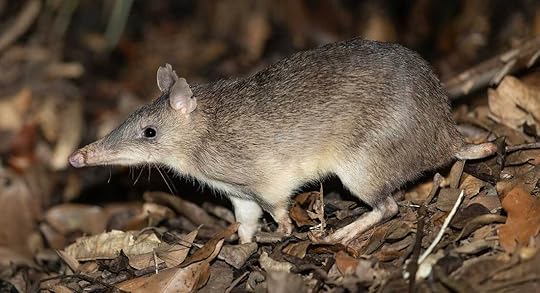
Photo Credit:
- Long-nosed bandicoot - JJ Harrison, CC BY-SA 4.0, via Wikimedia Commons
Samuel, the main character of Savage, encounters some very unusual bandicoots. No, not like Crash Bandicoot, the video game character, but these bandicoots are strange in a Stan-C-Smith-science-fiction kind of way.
Bandicoots are, of course, real animals. Some of them look kind of like rats, but they could hardly be more different. This photo is a long-nosed bandicoot.
Rats are rodents, which are placental mammals (more closely related to humans than to bandicoots). Bandicoots are marsupials (more closely related to kangaroos than to rats). Marsupials are unique among mammals in that their young develop mostly outside of the female's body instead of in a uterus inside the female's body. They are born VERY small, then they crawl to a pouch on the mother's abdomen, where they attach to a nipple and grow by feeding on mother's milk. Eventually, they get so big they can no longer stay in the pouch.
Bandicoots hop like rabbits when they run. They also have a high-pitched, bird-like call they use to locate each other.
Baby bandicoots are born after a very short gestation period—only 11 days (one of the shortest pregnancies of all mammals). Like with other marsupials, when they are born, they are tiny and they move out of the uterus and to the mother's pouch.
Bandicoots normally stand on all fours, and the mother's pouch is open facing the rear, to prevent dirt from entering the pouch as the mother digs for food.
And... male bandicoots have a "bifurcated" penis, with two ends. Why? Because the females have two vaginas. Actually, this is true of many marsupials... they have two vaginas, and two uteruses (uteri?). This allows marsupials to have several young (or litters of young) that are at different stages of development. For example, a kangaroo female can have a developing fetus in one uterus, a baby that is already born but is developing in her pouch, and another baby that is out of the pouch but is still young enough to be dependent. Pretty cool, huh?

Photo Credit:
- Long-nosed bandicoot - JJ Harrison, CC BY-SA 4.0, via Wikimedia Commons
Published on September 05, 2025 11:32
September 2, 2025
In our neck of the woods... Fawns and Doves
Two things I love about this time of the year in Missouri. First, the white-tailed deer fawns still have their spots (barely), but they are getting big enough that we occasionally see them out and about on their own. Remember, when fawns are small, they are much safer when they are alone, lying still in the vegetation of the forest floor, than when they are with their mother. The more hours per day the mother leaves them alone, the more likely the little fawns will survive. It's much more dangerous to be with the mother. Why? Because the mother is more visible, and more likely to draw the attention of predators. Which draws attention to the fawn. Most fawns taken by predators are those that are up and moving around, following their mother.
But now that fawns are large enough to outrun a coyote, it is safe for them to be with their mother (or even moving around on their own), and we see them more often. This fawn came into our driveway recently.
The second thing I love this time of the year is the soothing calls of mourning doves. For some reason, these haunting calls make me think of summers when I was a kid, staying in bed late on Saturday mornings and listening to the doves through the screens of the bedroom's open windows. It was a simpler time, so I try to rekindle those feelings whenever I hear them now. It seems we always have a few pairs of these birds near our house. Mourning doves are normally monogamous, mating for life (or until something happens to one of them).
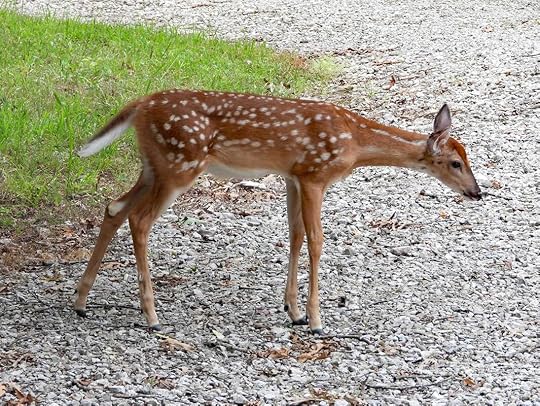
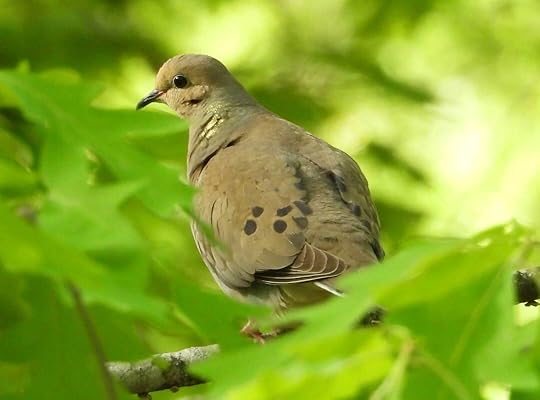
Photo Credits:
White-tailed deer fawn and mourning dove - Stan C. Smith
But now that fawns are large enough to outrun a coyote, it is safe for them to be with their mother (or even moving around on their own), and we see them more often. This fawn came into our driveway recently.
The second thing I love this time of the year is the soothing calls of mourning doves. For some reason, these haunting calls make me think of summers when I was a kid, staying in bed late on Saturday mornings and listening to the doves through the screens of the bedroom's open windows. It was a simpler time, so I try to rekindle those feelings whenever I hear them now. It seems we always have a few pairs of these birds near our house. Mourning doves are normally monogamous, mating for life (or until something happens to one of them).


Photo Credits:
White-tailed deer fawn and mourning dove - Stan C. Smith
Published on September 02, 2025 07:21



